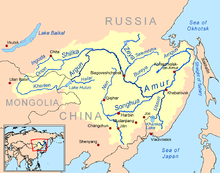| Argun | |
|---|---|
 | |
 | |
| Etymology | Derived from Proto-Mongolic *ergene 'wide' |
| Native name | |
| Location | |
| Country | China, Russia |
| Russian Krai | Zabaykalsky Krai |
| Chinese Region | Hulunbuir |
| Physical characteristics | |
| Source | Hailar |
| • location | Greater Khingan mountains |
| • coordinates | 49°56′13″N 122°27′54″E / 49.937°N 122.465°E |
| 2nd source | Kherlen |
| • location | about 195 kilometres (121 mi) from Ulaanbaatar |
| • coordinates | 48°N 109°E / 48°N 109°E |
| • elevation | 1,961 m (6,434 ft) |
| Mouth | Amur |
• coordinates | 53°20′N 121°28′E / 53.333°N 121.467°E |
| Length | 1,620 km (1,010 mi) |
| Basin size | 164,000 km2 (63,000 sq mi) |
| Discharge | |
| • average | 340 m3/s (12,000 cu ft/s) |
| Basin features | |
| Progression | Amur→ Sea of Okhotsk |
 | |
| Argun | |||||||
|---|---|---|---|---|---|---|---|
 Argun River in the Amur basin | |||||||
| Chinese name | |||||||
| Chinese | 额尔古纳河 | ||||||
| |||||||
| Mongolian name | |||||||
| Mongolian Cyrillic | Эргүнэ мөрөн | ||||||
| |||||||
| Manchu name | |||||||
| Manchu script | |||||||
| Romanization | Ergune bira | ||||||
| Russian name | |||||||
| Russian | Аргунь | ||||||
The Argun /ɑːrˈɡuːn/ or Ergune (Chinese: 额尔古纳河) is a 1,620-kilometre (1,010 mi) long river that forms part of the eastern China–Russia border, together with the Amur. Its upper reaches are known as the Hailar River (海拉尔河) in China. The Argun marks the border (established by the Treaty of Nerchinsk in 1689) between Russia and China for about 944 kilometres (587 mi), until it meets the Amur.